
UW ADRC research participants make it possible for scientists to discover fundamental mechanisms of Alzheimer's disease and related conditions and contribute to knowledge that will lead to therapeutics and prevention measures.
Every day, investigators publish studies that rely on biological samples or clinical data generously donated by those enrolled in the UW ADRC Clinical Core longitudinal study and the Adult Changes in Thought Study (ACT). The UW ADRC considers your contribution of data and specimens, including brain autopsies, to be the ultimate gift to future generations.
Visit this page to explore findings emerging from recent studies using data from research participants in the UW ADRC and Adult Changes in Thought Study (ACT). Highlighted studies will change over time. These publications were made possible in part by funding from the National Institute on Aging. Publications benefiting from UW ADRC resources are funded by P30 AG066509 (formerly P50AG005136). Be sure to check out our multimedia series, Brain Bytes!
Understanding How Alzheimer's Begins
Investigators from the Allen Brain Institute, UW Alzheimer's Disease Research Center, and Kaiser Permanente Washington Health Research Institute recently launched the Seattle Alzheimer’s Disease Brain Cell Atlas (SEA-AD) web product (SEA-AD.org) in July 2022. The UW ADRC is excited about the first public release of the project’s data, an important new resource for the Alzheimer’s community. The SEA-AD is a NIA-funded collaboration between the Allen Brain Institute, UW Medicine, and Kaiser Permanente Health Research Institute to create a higher resolution atlas of Alzheimer’s disease at the cellular level, in order to understand the early pathogenesis of AD, disease initiation, and cognitive decline. The publicly available dataset captures cellular and molecular information obtained from more than 1.2 million neurons and other brain cells from 84 participants in the Adult Changes in Thought (ACT) study who donated their brains to science after their deaths. The brain donations are coordinated through the University of Washington School of Medicine BioRepository and Integrated Research (BRaIN) laboratory.
- Read Cell-by-Cell: Scientists are building a high-resolution map of brain changes in Alzheimer’s disease (Allen Institute)
- Listen to “Alzheimer’s researchers are looking beyond plaques and tangles for new treatments” (NPR)
Resilience and Resistance
- Resilience is a brain's ability to cope and maintain cognitive function, despite having a load of pathology that would be expected to cause symptoms.
- Resistance is a natural ability to avoid ever developing a certain type of pathology in the brain.
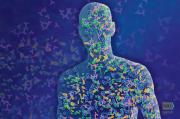
Researchers found that certain genes related to heart health, metabolism, and mental health may be involved in Alzheimer's disease resilience. It also found that genes linked to resilience may be related to protein pathways involved with regulating bile acid in the liver. This study highlights the importance of the liver-gut-brain axis in the study of Alzheimer’s resilience. This study used data from the Adult Changes in Thought Study and other longitudinal studies. (Dumitrescu et al. Brain, 2020) Learn More at NIA.

A new study suggests that a life full of light exercise and hobbies may slow disease progression and increase cognitive resilience, even for those who inherited gene mutations that cause frontotemporal dementia (FTD). The participants came from two large multisite studies, recently combined into the ALLFTD study, led by our colleagues at the UCSF Memory and Aging Center. The UW ADRC is one of the ALLFTD study sites and contributed participant data to this new research on resilience in FTD. (Casaletto et al. Journal of Alzheimer's & Dementia, 2020) Learn more at UW ADRC News.

Amyloid and tau proteins are the hallmarks of Alzheimer’s disease pathology. Clumps of other abnormal proteins can also be seen under a microscope, such as TDP-43. Abnormal TDP-43 pathology is seen in 1 in 5 individuals over 80 years old. ADRC researchers have found that developing TDP-43 may decrease a person’s resilience to Alzheimer’s disease pathology, meaning that TDP-43 may undermine the brain’s capacity to function despite the presence of Alzheimer’s disease. The team aims to understand why some brains develop this abnormal pathology in later life and some do not, to gain clues to resilience. The researchers relied on clinical data and brain tissue samples from participants in the Adult Changes in Thought Study (ACT). These samples were stored, analyzed, and studied in the ADRC Precision Neuropathology Core. (Lee at al. Brain Pathology, 2021) (Latimer et al. Acta Neuropathological Communications, 2019) Learn more at UW ADRC News.
- Learn more about the important relationship between the ACT and the UW Precision Neuropathology Core, read the article An Ecology of the Aging Brain: The Shared Project of the ACT Study and the ADRC.
Genetics
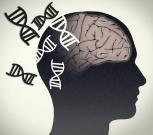
ADRC researchers analyzed genetic data from the Alzheimer Disease Genetics Consortium to compare the DNA sequences from more than 8,000 African Americans, with and without Alzheimer’s disease. The UW ADRC, along with multiple other ADRCs, contributes genetic data to this project. The researchers found that the main biological pathways linked to Alzheimer’s risk in African Americans largely overlapped with those in non-Hispanic white individuals, but several disease-associated genetic loci in these pathways differed. A genetic locus (plural: loci) is the specific, fixed position on a chromosome where a particular gene is located. Specifically, they found a link between kidney system development and Alzheimer’s risk in African Americans, suggesting another novel disease mechanism to explore. African Americans are three times more likely to experience kidney failure than non-Hispanic whites. They are also more likely to have both dementia and kidney disease. Differences in the genetic loci in these pathways could prove to be additional targets for further investigation into ethnic difference in risk. (Kunkle et al. Jama Neurol., 2021). Learn more (NIA).
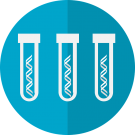
In a milestone study about genetic testing and counseling, ADRC researchers described the experience of persons with cognitive impairment receiving genetic testing and genetic counseling for inherited types of dementia. High levels of reported participant satisfaction suggested that genetic testing and genetic counseling can be used effectively with patients in this population in a clinical setting and provides insight to genetic counselors. Participants of this study came from the UW ADRC Clinical Core and the UW Memory and Brain Wellness Center. (Rolf B et al. Journal of Genetic Counseling, 2021) Learn more at UW ADRC News.
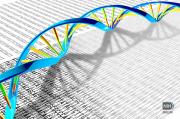
A new study at the intersection of genetic sequencing technology and human brain evolution reveals the workings of a repeat expansion linked to Amyotrophic lateral sclerosis (ALS) risk, for the first time. Researchers in the Valdmanis Lab used genetic samples from the UW ADRC to show that the new genetic factor specifically influences ALS risk and not Alzheimer's or Parkinson's risk. (Course et al. American Journal of Human Genetics, 2020) Learn more at UW ADRC News.
Potential Therapeutic Targets
__ex-sm.jpg)

At the UW ADRC, researchers are focusing attention on misfolded tau protein, another culprit in brain diseases that cause dementia. New UW research finds that targeting abnormal tau through the suppression of a gene called MSUT2 shows promise. This study gives new reasons why drug companies should focus on tau pathology in search for Alzheimer's cure. Samples of postmortem brain tissue from the ADRC Neuropathology Core made this discovery possible for researchers in the Kraemer Lab. (Wheeler et al. Science Translational Medicine, 2019) Learn more at UW ADRC News.
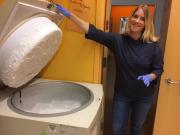
Brain autopsy has long been the only definitive method of diagnosing the exact neuropathological changes in neurodegenerative disease. In this study, fresh and flash-frozen leptomeningeal brain cells from donated autopsy specimens were successfully used to generate new in-vitro stem cell models that reflect unique biological profiles. This method will help researchers study the mechanisms of late-onset Alzheimer’s disease and other age-related neurodegenerative diseases with greater precision. (Rose et al. Journal of Neuropathology and Experimental Neurology, 2018) (D'Souza et al. Journal of Neuroscience Research, 2020) Learn more on UW ADRC News
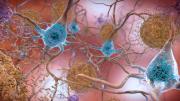
The brain's noradrenergic system produces a neurotransmitter called norepinephrine, or the brain’s adrenaline. In people living with Alzheimer's disease, hyperactivity in this system can lead to symptoms of agitation, sun-downing, and sleep problems. This study used samples from the ADRC brain bank, data from longitudinal studies, and mouse models to investigate the role of the noradrenergic system in the development of Alzheimer's disease. Their findings demonstrate that amyloid pathology rewires the noradrenergic system, in a way that may activate the production of pathological tau protein. These new insights into amyloid toxicity have strong implications for the design of drugs that clear amyloid from the brain, as well as the interpretation of current clinical trials of anti-amyloid drugs. (Zhang F et al. Science Translational Medicine, 2020) Paper
Caregiver Health

A study out of the UW Psychiatry and Behavioral Sciences Department focused on the health of caregivers. The study aimed to examine the relationship between caregiver status and psychological distress, burden, and health behaviors, such as exercise and diet, over 2 years. The results of this longitudinal study suggest that caregivers, compared with non-caregivers, may lack proper nutrients, and that the hours spent caregiving may limit the time it takes to practice self-care and healthy behaviors, such as the preparation of well-balanced nutritious meals. The researchers thank UW ADRC participants for helping to make this study possible. (Snyder and Vitaliano. American Journal of Alzheimer’s Disease & Other Dementias, 2020) Paper

A team of researchers from the UW School of Nursing and UW Medicine recently completed a pilot evaluation of a digital intervention designed to help support caregivers of people with Lewy body dementia. The primary goal of this intervention, called Virtual Online Communities for Aging Life Experience-Lewy Body Dementia (or VOCALE-LBD), is to promote resilience and reduce stress in this vital population. With help from the UW ADRC, the research team recruited 15 family caregivers of people living with Lewy body dementia to participate. VOCALE-LBD is an 8-week interventional program conducted over a web-based discussion platform (that is moderated by study staff) and designed to enable peer-to-peer support, education, training, and problem-solving skill practice. (Zaslavsky et al. JMIR Formative Research, July 2022) Learn more at UW ADRC News.
Metabolism, Diet, and Cognition

This study involving UW ADRC participant data found that adults who carry the APOE E4 gene variant performed better on memory tests after eating a high fat meal, compared to eating a high carbohydrate meal. This suggests that people with the APOE E4 genotype have a different ability to transport lipids into the brain vs. carbohydrates. Ever since, the evidence continues to accumulate around the idea that APOE genotype influences cognitive and neurological responses to diet and dietary supplements. The researchers now aim to understand how nutritional interventions may impact Alzheimer's disease progression. (Hanson et al. Journal of Alzheimer’s Disease, 2015) (Farmer et al. Current Opinion in Lipidology, 2019) Learn more
Prevention and Modifiable Risk Factors

Seattle.gov
A UW-led study has identified a link between air pollution and elevated dementia risk. The study’s findings are based on extensive local data resources from the the Adult Changes in Thought Study (ACT) and measurements of air pollution in the Puget Sound area collected since the late 1970s. The final analysis showed that 1 microgram per cubic meter difference in the levels of fine particle pollution between residences was associated with 16% higher incidence of dementia. For context, the authors note that in 2019 there was approximately 1 microgram per cubic meter difference in PM2.5 pollution between Pike Street Market in downtown Seattle and the residential areas around Discovery Park, to the northwest. This study adds to the growing body of evidence suggesting air pollution has neurodegenerative effects and that reducing people’s exposure to air pollution could help reduce the burden of dementia. (Shaffer et al. Environmental Health Perspectives, 2021). Learn more at UW ADRC News.

Researchers found that older people who undergo cataract surgery to improve their eyesight are less likely to develop dementia from any cause compared with those who did not. During follow-up of 3,038 ACT study participants (an average of 7.8 years per person), 853 subjects developed dementia, with 709 cases of Alzheimer disease. Approximately half of the participants (1,382 individuals, or 45%) had cataract surgery. Analysis for risk of developing dementia showed that subjects who had undergone cataract surgery in either eye were about 30% less likely to develop any form of dementia for at least 10 years after their surgery. This lowered risk persisted for at least a decade after surgery. Cataract surgery was also associated with lower risk of Alzheimer disease dementia specifically. (Lee CS et al. JAMA Intern Med, 2021). Learn more.

A recent UW study investigated the link between high glucose and dementia using data from the ACT study, including glucose measures, diabetes and antihypertensive treatments, and blood pressure data on 3,056 participants, with a mean age of 75.1 years, without diabetes treatment and 480 with diabetes. The researchers found that higher glucose levels were associated with greater dementia risk among people, both with and without treated diabetes, in line with previous work. However, hypertension and antihypertensive treatments did not appear to affect the association between glucose and dementia risk in the ACT Study. This finding suggests that taking high blood pressure medications may not make a difference in the dementia risk linked to high glucose levels, for older adults. Future studies are still needed to examine this question among midlife adults and to see if there is any variation in results when different types of antihypertensive treatments are tested individually. (Zhou J et al. Journal of Alzheimer's Disease, 2021) Learn more.

The Lancet Commission 2020 Report on Dementia Prevention, Intervention, and Care report suggests that 40% of all dementia cases worldwide may be prevented by addressing a group of risk factors: high blood pressure, obesity, hearing loss, late-life depression, diabetes, physical inactivity, smoking, social isolation, lower levels of education, alcohol consumption over 14 drinks a week, traumatic brain injury, and air pollution. Fortunately, existing public health interventions and personal lifestyle changes can help prevent or reduce these risks. Behind the list of preventable risk factors in the 2020 Lancet Report is a wealth of research findings from the long running Adult Changes of Thought Study (ACT) in Seattle. Explore the most significant ACT Study findings from the past three decades about what’s helpful and what’s not
Brain Injury

In the largest ever study on the topic, ADRC researchers found that suffering a single serious head injury (with loss of consciousness) before age 25 leads to a three-fold elevated risk for Parkinson’s disease and Lewy body accumulation in later life. They did not detect a raised risk for Alzheimer-type dementia in this study, which used data from the Adult Changes in Thought Study. (Crane et al. JAMA Neurology, 2016) Learn more

Severe traumatic brain injury (TBI) damages neurons and affects the expression patterns of proteins implicated in Alzheimer’s disease. In a study using a mouse model of TBI, as well as tissue from the ADRC brain bank, researchers demonstrated that a protein called asparagine endopeptidase plays a key role in Alzheimer’s disease pathologies induced by TBI. Their findings support the potential of asparagine endopeptidase as a novel drug target for treating the later effects of TBI. (Zhourui et al. Progress in Neurobiology, 2020) Learn more about TBI research at the ADRC.
_
For questions on this page, please email gwanucha@uw.edu.






